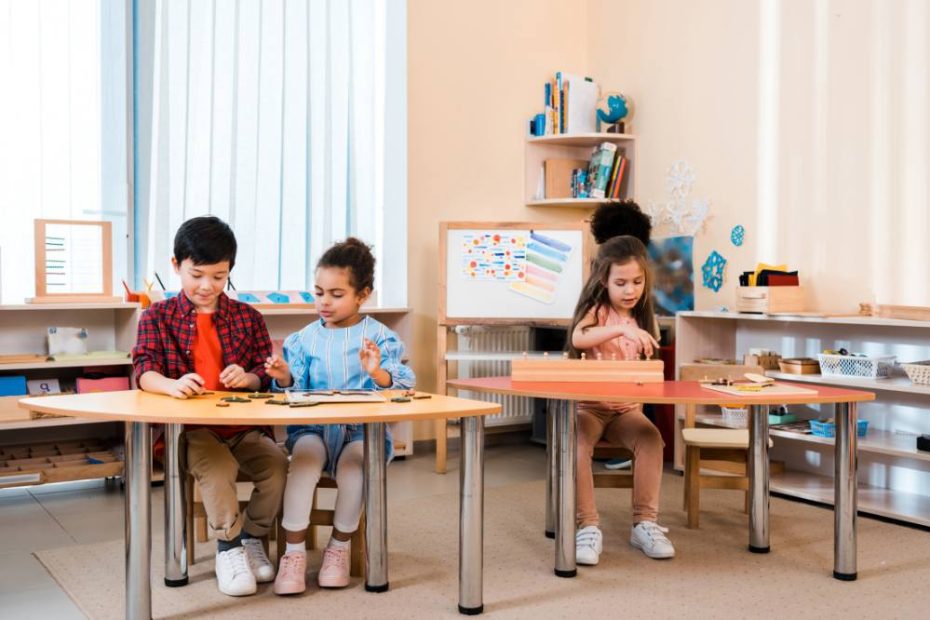Dr. Maria Montessori’s Philosophy of Hands-On Learning with Montessori Material
Dr. Maria Montessori’s groundbreaking contributions to education have transformed the way we nurture young minds. Her revolutionary teaching theory, philosophy, and hands-on approach have left an indelible mark on preschool education, challenging traditional methods and shaping a new path for children’s development.
Born in 1870 in Italy, Maria Montessori defied societal norms, venturing into the male-dominated fields of medicine and education. Her experiences as a doctor and her work with children with learning disabilities led her to develop a unique perspective on education.
Montessori’s Teaching Philosophy
Montessori’s teaching philosophy is rooted in the belief that children are natural learners, capable of absorbing knowledge from their environment. She viewed the early years as a critical period for mental and emotional development. Her approach focused on fostering independence, self-discovery, and a lifelong love of learning.
The Montessori Method | Hands-On Learning
Central to Montessori’s teaching method is the prepared environment. She believed carefully selected and organized materials for the specific age group of the children in the classroom could stimulate a child’s curiosity and drive for exploration. In a Montessori classroom, children have the freedom to choose activities that resonate with their interests, allowing for personalized and self-directed learning.
Montessori classrooms emphasize hands-on learning, where children engage with tangible materials to grasp abstract concepts. Through activities like counting with beads, tracing letters, and pouring liquids, children develop cognitive and motor skills simultaneously. This experiential learning not only promotes intellectual growth but also instills a sense of accomplishment and self-confidence.
Maria Focused on Practical Life Skills unlike Traditional Education
Unlike traditional education, which often follows a one-size-fits-all approach, Montessori education is tailored to each child’s unique pace and style of learning. Teachers serve as guides, observing each child’s progress and providing guidance when needed. This approach empowers children to take ownership of their learning journey, fostering a sense of responsibility and self-motivation.
Montessori education goes beyond academics. Practical life skills, such as pouring water, tying shoelaces, and setting the table, are integrated into the curriculum. These activities not only contribute to a child’s physical development but also cultivate a sense of order, concentration, and refined motor skills.
Montessori’s vision was not limited to the preschool years. She believed that her approach laid the foundation for lifelong learning. By nurturing a child’s natural curiosity, critical thinking, and problem-solving abilities, Montessori education equips children with the skills they need to thrive in an ever-changing world.
Maria Montessori Encouraged Learning with Selected Material: Montessori Materials
In Dr. Maria Montessori’s innovative teaching method, the role of carefully chosen materials is paramount. These materials, designed to engage young learners, facilitate hands-on exploration, and encourage independent thinking, form a crucial component of the Montessori classroom experience.
Montessori learning materials are meticulously crafted to align with children’s developmental stages and their innate curiosity. These materials encompass a wide range of subjects, including mathematics, language, sensorial exploration, practical life skills, and cultural studies.
Hands-On Exploration: One of the cornerstones of Montessori education is the emphasis on tactile learning. Children interact with concrete materials that represent abstract concepts, aiding in comprehension and retention. For instance, Montessori math materials, such as the “golden beads,” help children understand complex arithmetic operations by manipulating physical beads to visualize numbers and quantities.
Sensorial Materials: The Montessori sensorial materials engage children’s senses, fostering the development of keen observation skills. Through materials like the “pink tower” (a set of graduated cubes) or the “color tablets,” children explore concepts like size, color, shape, texture, and sound. These experiences help refine their perceptions of the world around them.
Practical Life Materials: Montessori classrooms feature practical life materials that encourage children to engage in everyday tasks. These activities, like pouring water, polishing, or arranging flowers, not only refine motor skills but also instill a sense of order, concentration, and self-sufficiency. Children learn to care for themselves and their environment.
Language and Cultural Materials: Montessori language materials, such as sandpaper letters and moveable alphabets, introduce reading and writing in a multisensory manner. Additionally, cultural materials expose children to geography, history, and science. Globes, maps, and puzzles inspire exploration of the world’s continents, countries, and ecosystems.
Montessori Classroom Environment: In a Montessori classroom, these materials are thoughtfully arranged on open shelves, easily accessible to children. This arrangement encourages independent decision-making and fosters a sense of responsibility for their learning. Teachers guide students in using the materials but ultimately empower them to choose activities based on their interests and developmental needs.
Holistic Development: Montessori materials and their hands-on nature address not only academic development but also social and emotional growth. They promote concentration, problem-solving, and a love of learning. By allowing children to explore and make discoveries at their own pace, these materials nurture their innate curiosity and creativity.
Conclusion
Dr. Maria Montessori’s educational philosophy extends beyond conventional classroom materials. Her emphasis on independence, personalized learning, and practical life skills has challenged conventional teaching methods and empowered generations of young learners. The carefully designed Montessori learning materials play a pivotal role in nurturing a child’s holistic development. These tools ignite a lifelong passion for learning, encourage critical thinking, and empower children to embrace a journey of exploration and self-discovery in the classroom and beyond.

